What's the most useful tool you own? Your phone? A laptop?
These devices do provide us with a nearly infinite stream of information and knowledge, but there is a device, virtual reality, that can do all that and so much more. Behind the plastic goggles is a place where you can do nearly anything. Play games, watch movies, meditate, join chat rooms, exercise, explore the world, you name it.
Specifically, I am talking about immersive virtual reality (IVR), the type of virtual reality provided by headsets like the Oculus Rift, HTC Vive, PlayStation VR, and others... just to name a few. These products have become more and more popular as they have become more affordable and more content has been published for them.

When mainstream virtual reality once became popular, there was doubt and concern cast upon the technology. There were many concerns about the adverse side effects, both physically and socially. Even online forums were opened, dedicated to only posting photos and videos of people injuring themselves while using virtual reality.
These critics did have a good reason to be concerned though. Virtual reality offered a place where you could escape the world, talk with people on the other side of the planet, and was host to countless streams of entertainment.
However, virtual reality can be used for more than just entertainment.
- Technology usage has become a staple in public education, and schools have moved to adopt new ways to use technology in the classroom such as iPads or laptops. And now, virtual reality can offer unique and valuable benefits to students and educators alike.
- Nowadays, companies and businesses struggle to keep up with the pace that technology is evolving. With the growing use of virtual reality, companies may be able to utilize the benefits that virtual reality offers.
- Senior living arrangements may able to raise the quality of life of their residents, as well as better care for dementia patients.
Virtual Reality in the Classroom
Almost from the very beginning of my education, technology has always been present. At the very very start, we only had one computer lab in the school. We got to play around on them using a program called KidPix, which is somehow still around today. It was back when software was installed using discs.
Then we were able to use laptops for an hour at a time, making Word documents for poems and bullet-point research reports. Then we learned touch-typing, with the rubber keyboard covers to make us memorize the keyboard, which my peers may or may not have cheated at.
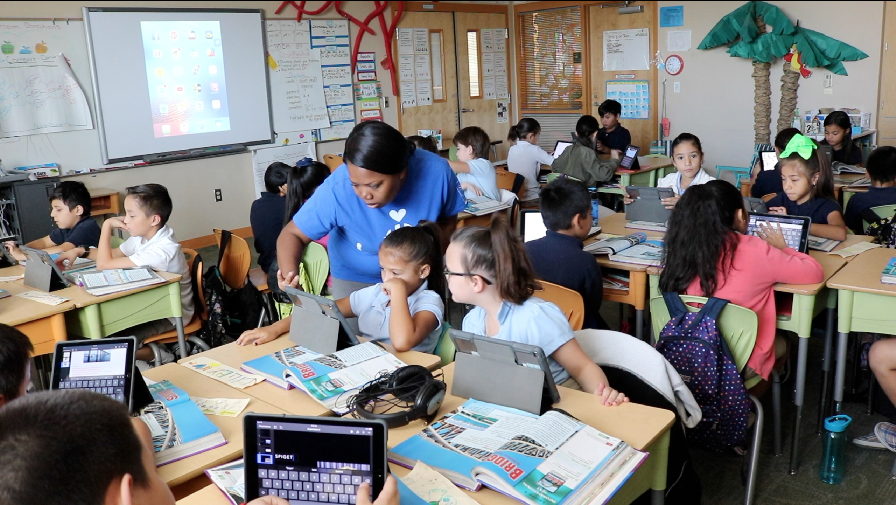
We also got to see digital whiteboard to slowly roll into a few classrooms, still being projector based, but using "fake" whiteboard pens and erasers.
Through middle school, we had received personal iPads and were able to use desktop computers across the school, writing essays, making presentations, and editing photos. Through a few lessons, we were able to use Google Cardboard to explore historical landmarks, though it was never truly "immersive."
In high school almost everyone owned a laptop or a phone, and was able to create well-developed essays, websites, and more. Research was done more professionally in preparation for college.
Teachers embraced the new technology, resources and assignments was almost exclusively ran online, having assignments being required to be turned in online. This was further amplified throughout the pandemic, where everyone had to transition to an online learning environment.

Virtual whiteboards got an upgrade, no longer needing a projector with the capabilities of being connected to the internet.
What about right now? In college, creating a blog post for an assignment, where some classes are held completely online, where we can have "face-to-face" conversations in another language with people across the world in real-time.
In my 13 years of K-12 education, I have seen iPads, laptops, even digital whiteboards being used in the classroom, but what's next for the new generation of students starting their educational career? What kind of technology will they be able to experience? Artificial intelligence (ChatGPT)? Holograms? But what about... virtual reality?
Research
Di Natale, in her 10-year systemic review, included study involving a large group of seventh graders learning a new math concept (quadratic equations, yuck), where the virtual reality group learned by gameifying the lesson.
A week later, a post-test was given and the virtual reality group had shown great improvement, but not those in the control group. These conclusions show that the use of virtual reality can deepen understanding academically which results in higher exam scores, but another way virtual reality can help academically is through meditation.
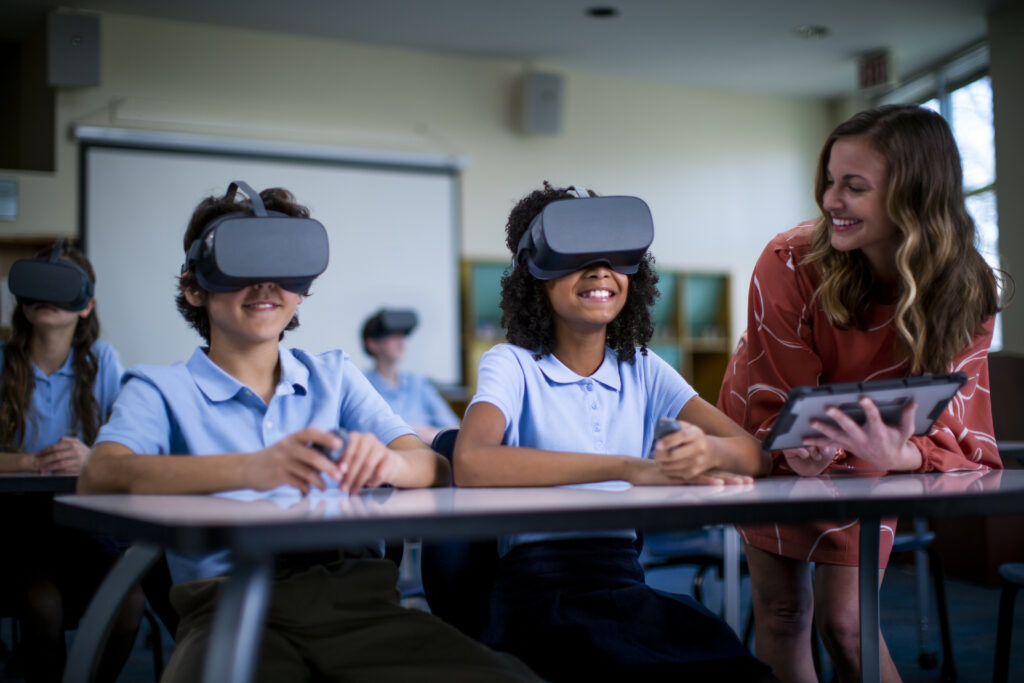
A study conducted by Regina Kaplan-Rakowski and her team found that meditation using virtual reality had significantly reduced levels of stress and anxiety, which could lead to an increase in academic performance.
The majority of students had asserted that meditation to be helpful and that the use of virtual reality meditation had helped them achieve better scores on the exam.
These kind of benefits are the things students are yearning for. Just during the pandemic, more than one in every three students had claimed that their mental health was not good during the pandemic including stress, anxiety, and depression. Research still suggests that students have not recovered yet.
If virtual reality can help students achieve not just better exam scores, but better understanding of the subjects at hand, and if virtual reality can relieve stress and anxiety from students, educators and board members should highly consider adopting this new and upcoming technology.
Virtual Reality in the Workspace
Boosting productivity is a key factor in any organization's decisions.
Some companies may have invested in robots, who can do repetitive and straining tasks over and over without mistakes, and more importantly, without needing a break or getting paid. Some companies try to automate many portions of their business, such as restaurants creating a website for customers to order online, where employees no longer need to spend their time taking orders over the counter or over the phone, which is wages coming out of the business's pocket.
Because of this, we have seen the rise of services such as DoorDash and Uber Eats which provide delivery services to businesses and restaurants that may not be able to afford their own in-house delivery team.

What many occupations have done is providing multiple monitors to their employees for their computers. Many desk jobs have two to three. Air traffic controllers, a job known for needing immense multitasking skills, often work with four or five. 911 operators might even go as far as to use up to eight.
Virtual Workspaces
While multitasking can be easier and more information can be displayed at the same time, the use of multiple, especially large, monitors comes with some drawbacks. Mcgill, in his report, addresses this issue when discussing the issues brought up when using three or more monitors:
Viewing wider display spaces leads to the activation of different muscle groups than viewing a single display. Nimbarte et al. noted that "Increased activation of anterior neck muscles caused by asymmetrical, more rotated head-neck postures... may increase the risk of neck musculoskeletal disorders, especially with prolonged computer use"
In their research, Mcgill and his team aimed to find the benefits of using a "virtual workspace" versus a traditional workspace. One key difference that Mcgill investigated was the difference between using deadzones and mapping the head angle of the user to the head angle displayed to the user in virtual reality.
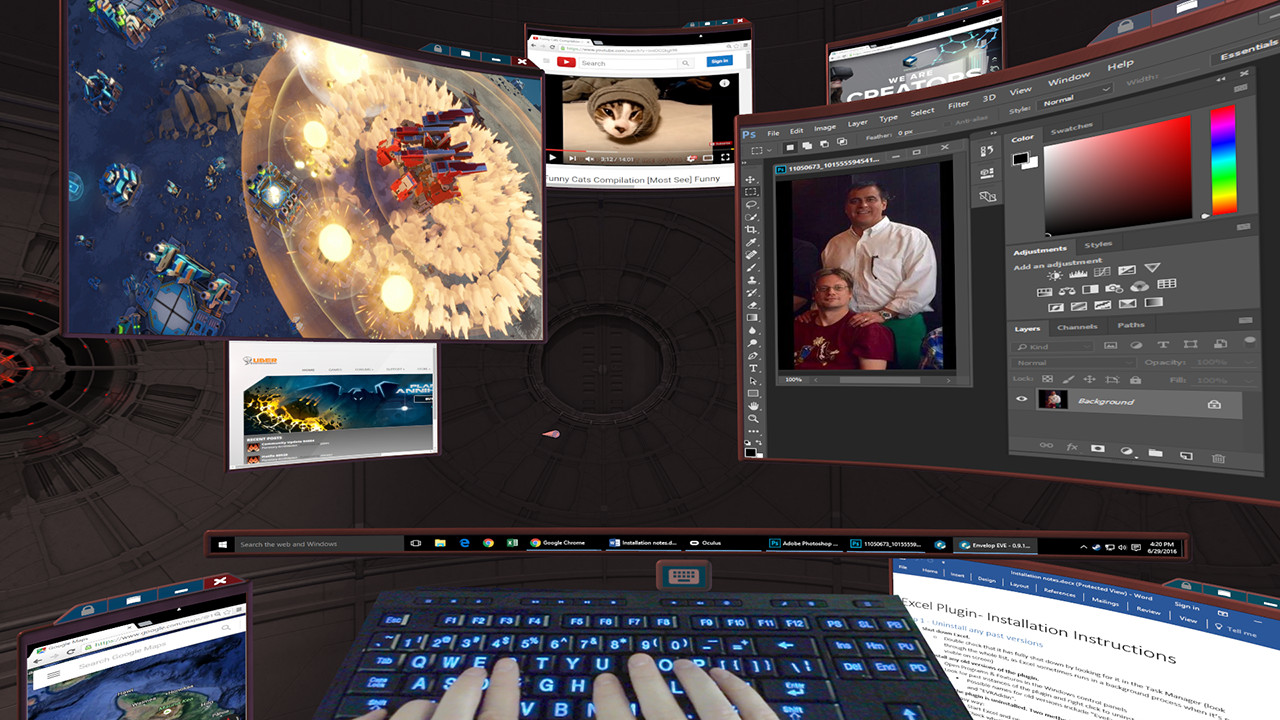
This means that users could opt for an option that could map their real head movement to virtual movement, so that their "virtual head" can look 90 degrees to the right in virtual reality, when they only move their head 45 degrees (half the angle) in real life, therefore reducing the amount of neck strain when utilizing multiple monitors.
I have been able to experience such technology myself with a small device called TrackIR, which commonly maps head movements to camera movements in flight simulation games.
In a test with three and five virtual monitors, the most common result participants reported was discomfort when having no mapping applied to their head rotation. But when mapping was applied, far fewer participants reported discomfort, and instead, a majority of participants said they felt no discomfort at all.
In the end Mcgill (2020) had concluded that:
...using and manipulating this mapping helped VR users access wider display spaces whilst minimizing neck fatigue and discomfort...
In a follow-up study, Mcgill (2020) found that participants could be more productive if they had implicit control over the virtual display positions. This was followed up by a suggestion that the use of virtual workspaces could improve productivity in small environments such as cars and planes and could expand the amount of display space available.
The use of virtual reality when it comes to virtual workspaces allows users to work in spaces such as the backseat of a car, with the productivity they would have at a traditional desk with the benefit of a reduction in neck strain. With career-long occupations, especially where the use of a computer each day is required, the reduction in neck strain could lead to a boost in productivity and a healthier lifestyle, where injuries like RSI are less of an issue.
Virtual Reality and the Elderly
Finally, virtual reality can even be used among the elderly, even when the technology has not been around for the majority of their lifetime.
"Entertainment" technology and even gaming have previously been brought into senior living arrangements (long-term care, retirement homes, etc…) for residents to use. Game consoles, notably the Nintendo Wii, have seen their place being used by senior citizens. It's simple in nature, games like Wii Sports simulated sports and could evoke old memories, and it creates a generational bridge.
Funnily enough, an entire league was created, called the National Senior League which runs events to this day.
VR for Dementia Patients
Now, virtual reality has the opportunity to completely change the lives of these senior citizens.In 2021, Vienna Rose conducted a study with participants with moderate to severe dementia in psychiatric care to find out if virtual reality use was feasible.
In one case, it had concluded that the use of virtual reality evoked old memories, with one participant even stating, "it reminds me of the old days."
Overall, the vast majority of participants showed interest in the technology, with only a few people mentioning any sort of motion sickness. Words like "exciting," "fun," and "interesting" were also commonly used to described the experience.
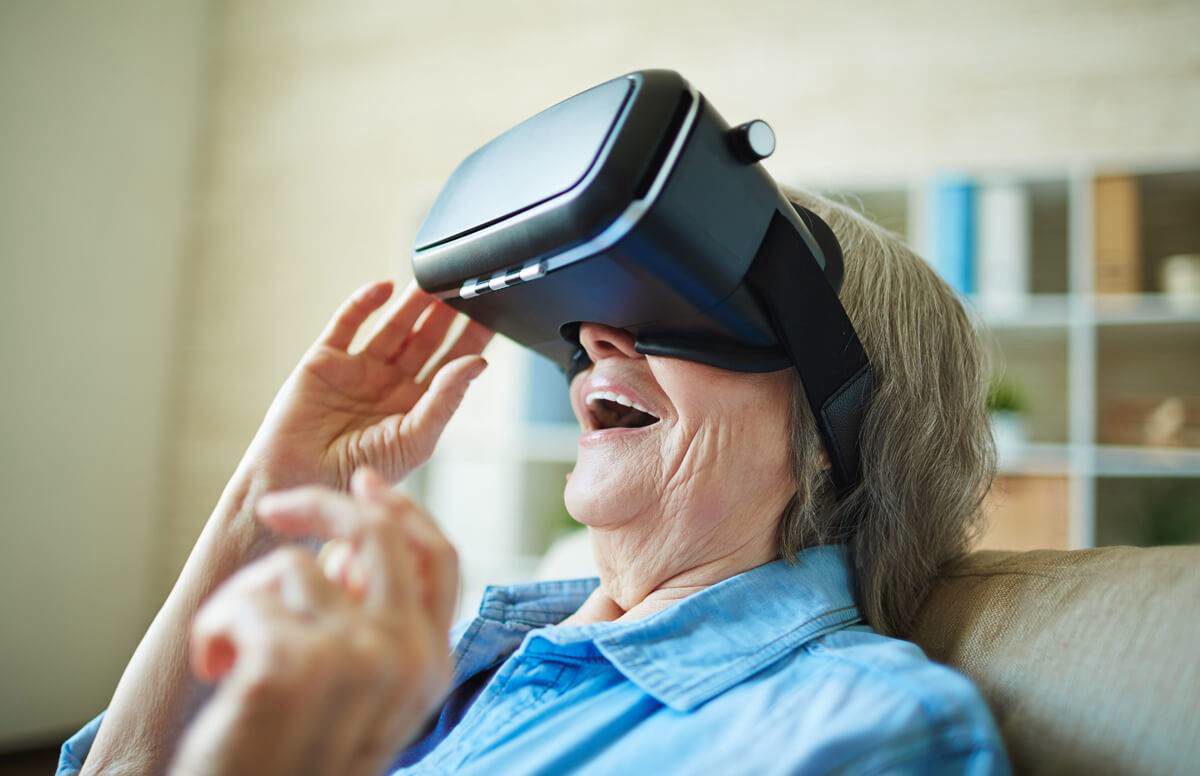
While many may take the technology for granted, the way the participants had described virtual reality was really humbling. They described it as feeling real and felt like they "were 'in' the VE (virtual environment)."
Physical Therapy?
In Eling Bruin's article about the potential use of virtual reality and the elderly, he states that:
Several studies have since emerged suggesting the potential of virtual reality as a successful treatment and assessment tool in a wide variety of applications, most notably in the fields of motor, and cognitive, rehabilitation.
Because of the simulation that virtual reality offers, Bruin claims that virtual environments can include "...motor learning enhancing features that activate motor areas in the brain..."
An example of a stepping rhythm game is later used in the article to explain how playing the game could help the elderly better train their step timing and direction, leading to less falls, trips, and missteps.
The entertainment one may receive from playing video games in virtual reality may serve as a pseudo-physical therapy session for others.
Because strength and functional capabilities are often lost at an older age due to inactivity, virtual reality can offer experiences that would be challenging to provide otherwise. These activities may motivate the elderly to be more active, just as a number of participants had asked for more time in virtual reality in the first study.
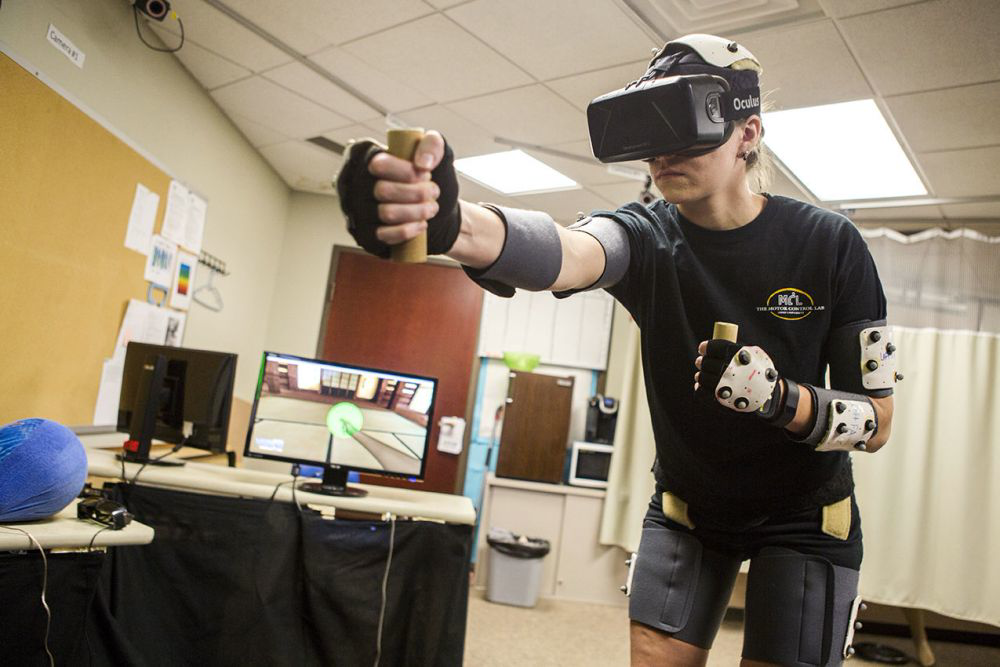
If the elderly with dementia can better recall memories and even have their motor control trained by the use of virtual reality, it certainly raises the quality of life, especially in a place like a hospital.
Concluding Thoughts
While virtual reality may be seen as an outlet for entertainment for most, virtual reality is a host to many other positive effects for people of all ages.
- For students, virtual reality can assist in learning new information and retaining that information better for exams. In a high-pressure environment like college, virtual reality offers a much more immersive and effective method of meditation for stress and anxiety reduction.
- Virtual reality can boost productivity within the workspace by creating virtual workspaces without the space limitation of a traditional desk while allowing the user to work in untraditional locations like a car or plane.
- Virtual reality also allows the user to create any display layout they would like, while simultaneously making working more comfortable by mapping the user's head movements to the monitor positions in a way that reduces the distance the user needs to turn their head to view any given display.
- Virtual reality has been** proven to help people with dementia to recall old memories** and improve their moods, all of which can lead to a better quality of life, and a reduction in stress, anxiety, depression, and hostility.
- Virtual reality has also been able to improve motor control among the elderly, reducing falls, and improving balance.
Virtual reality is not just for the young and certainly isn't just for gamers. Virtual reality offers benefits for everyone, regardless of age, and will continue doing so in more and more ways as technology is further explored in the coming years.
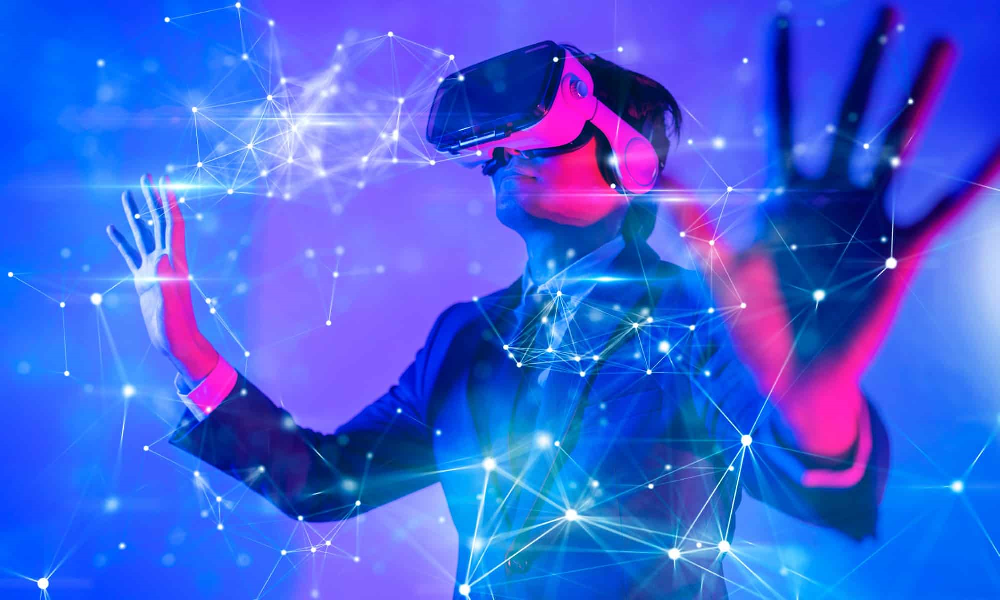
As creators continue to innovate, consumers must keep an open mind and embrace the possibilities that lie ahead. We are living in a time where the technology around us has been the most malleable it has been in a while.
Artificial intelligence has been evolving at an unfathomable rate, and at the moment we only seem to be poking at it like children and seeing how it reacts. Robotics has still been top of mind, as to what it can do in the future.
And now virtual reality, over many hurdles, has been more relevant and affordable than ever, and as history has shown itself, innovation begets innovation. Who knows where this technology will go next.
References
DOI
- 10.1177/1471301219868036
- 10.1145/3380959
- 10.1111/bjet.13030
- 10.1186/s40561-021-00166-7
- 10.1007/s00391-010-0124-7
Images
- https://www.sjpl.org/virtual-reality
- https://tophat.com/blog/smart-choices-tech-classroom/
- https://azednews.com/technology-classroom-increases-creativity-decreases-discipline-issues/
- https://vrscout.com/news/lenovo-vr-classroom-3-new-updates/
- https://eriecountypa.gov/departments/public-safety/divisions/911-center/
- https://www.roadtovr.com/virtual-reality-desktop-compared-oculus-rift-htc-vive/
- https://www.nextavenue.org/virtual-reality-travel/
- https://www.vrfitnessinsider.com/vr-transforms-physical-therapy-one-baby-boomer-time/
- https://history-computer.com/the-metaverse-vs-virtual-reality/